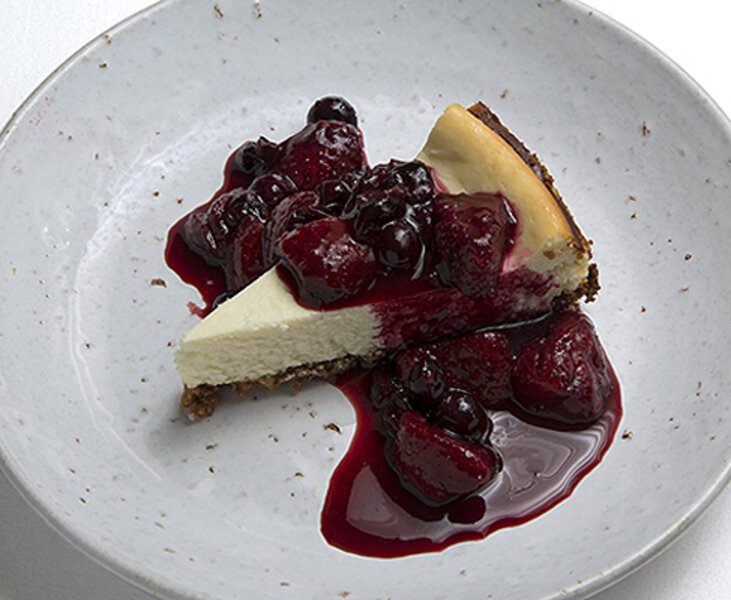Serves 12
For the crust
2 cups roasted hazelnuts
1/4 cup sugar
2 tablespoons butter, melted
For the filling
2 8-ounce packages cream cheese
12 ounces chevre (we use Costco’s or Trader Joe’s)
1/2 cup sour cream (or crème fraîche)
1-1/2 tablespoons fresh lemon juice
Scant 1/2 cup sugar
1 teaspoon vanilla extract
1 teaspoon salt
3 eggs
1 tablespoon flour
For the compote
1 cup blueberries, divided in half
1 cup strawberries, topped and cut into big chunks
1/4 cup water
1/4 cup sugar
1 tablespoon fresh lemon juice
1. Make the crust. Put about 2 cups of hazelnuts into the food processor with 1/4 cup of sugar and process in bursts until the hazelnuts are finely ground. Go carefully! I process this in bursts, taking off the lid and stirring everything to ensure that the nuts grind finely and evenly. You do not want to overprocess and turn this into a mass of hazelnut butter. Working in bursts and keeping an eye on the outcome are essential to yield a consistency that is fine-ground without releasing the oils that will turn this into a butter.
2. Turn the hazelnuts into a small bowl and add 2 tablespoons melted unsalted butter. Mix until everything is blended together.
3. Prepare the springform pan: butter or oil the bottom and sides of the pan. Press the hazelnut mix into the bottom only of the pan. You don’t have to use all of it. The idea is to have an even, thin crust.
4. Prepare the cheesecake batter. About an hour beforehand, take the cheeses, the sour cream and the eggs out of the fridge and let them come to room temperature.
5. Preheat oven to 350 degrees F. Put the cheeses in a big mixing bowl and, using an electric hand mixer, beat until they are mixed together. Scrape down the sides. Add the sour cream, vanilla, lemon juice, salt, and sugar and mix again until everything is incorporated together. Scrape the sides again, if possible, scraping with one hand while wielding the mixer with the other (you don’t have to worry about this juggling act if you have a stand mixer).
6. Add eggs and beat again. At this point, the batter will suddenly become sleek and fluffy in appearance – it will just look beautiful and you will know it is right. Finally, sprinkle the tablespoon of flour over all, and mix again very briefly.
7. Bake the cake. Scrape and pour the batter into the prepared springform pan and slide it into the center of the hot oven. Bake for about 50 minutes. Bake until the edges are set and slightly pulling away from the side, the top is subtly golden, and the center is still slightly wobbly. I am not talking about a general overall wobble but something more subtle, concentrating in the maybe three inches of the center. If the top cracks, that is OK.
8. Meanwhile, make the compote. Put half the blueberries, all the strawberries, water, lemon juice, and sugar in a pan. Turn on the heat and simmer. After 5 minutes of simmering, add the rest of the blueberries. Cook five minutes more. Remove from heat. Let it cool. You may also serve this on pancakes, French toast, ice cream, or plain yogurt.
9. Cool the cake completely. When it has cooled, run a knife around the edge, loosen the springform ring, then remove it. Cut into wedges – this should produce at least 12 wedges – plate, spoon the compote artfully on the plate, and serve.







